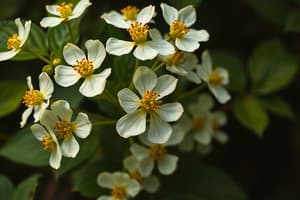Podcast
Questions and Answers
What is the main issue associated with synthetic chemicals in the context of beehive collapse?
What is the main issue associated with synthetic chemicals in the context of beehive collapse?
- They can persist in the environment for extended periods. (correct)
- They are immediately broken down into harmless products.
- They are not effective at all in pest control.
- They generally degrade faster than natural substances.
Which of the following statements accurately describes secondary metabolites in plants?
Which of the following statements accurately describes secondary metabolites in plants?
- Most of them are induced in response to biotic stress.
- They include primary nutrients necessary for plant growth.
- Secondary metabolites are primarily responsible for photosynthesis.
- They contribute to over 60,000 different varieties in plant defense. (correct)
What types of secondary metabolites are classified under alkaloids?
What types of secondary metabolites are classified under alkaloids?
- Terpenes and isoprenes.
- Complex carbohydrates and fatty acids.
- Simple sugars and vitamins.
- Compounds containing nitrogen derived from amino acids. (correct)
What is the primary purpose of constitutive plant defenses?
What is the primary purpose of constitutive plant defenses?
Which process is involved in the regulation or transfer of secondary metabolite production in plants?
Which process is involved in the regulation or transfer of secondary metabolite production in plants?
Which alkaloid is derived from the opium poppy and is used as a sedative?
Which alkaloid is derived from the opium poppy and is used as a sedative?
What is the primary function of lignins in vascular plants?
What is the primary function of lignins in vascular plants?
Which phenolic compound is known for its antimicrobial properties and is used for rot prevention?
Which phenolic compound is known for its antimicrobial properties and is used for rot prevention?
Which alkaloid is recognized as a very effective insecticide?
Which alkaloid is recognized as a very effective insecticide?
What type of reaction do tannins engage in with proteins?
What type of reaction do tannins engage in with proteins?
Which of the following alkaloids is specifically used as a local anaesthetic?
Which of the following alkaloids is specifically used as a local anaesthetic?
What is a common human use of phenolic compounds?
What is a common human use of phenolic compounds?
What percentage of a plant's dry mass can be constituted by defensive chemicals?
What percentage of a plant's dry mass can be constituted by defensive chemicals?
Which alkaloid is sourced from Ephedra and is used to treat hypotension?
Which alkaloid is sourced from Ephedra and is used to treat hypotension?
Which group of secondary metabolites includes over 40,000 types and is based on a 5-carbon skeleton?
Which group of secondary metabolites includes over 40,000 types and is based on a 5-carbon skeleton?
Which of the following terpenes is known for its medicinal properties as an antimalarial?
Which of the following terpenes is known for its medicinal properties as an antimalarial?
What characteristic of smaller terpenes makes them useful for plants?
What characteristic of smaller terpenes makes them useful for plants?
Alkaloids, which target the nervous system, are synthesized from which of the following?
Alkaloids, which target the nervous system, are synthesized from which of the following?
What is one of the uses of carotenoids in plants?
What is one of the uses of carotenoids in plants?
What function do terpenes serve in attracting pollinators?
What function do terpenes serve in attracting pollinators?
Which of the following is NOT a group of secondary metabolites as mentioned?
Which of the following is NOT a group of secondary metabolites as mentioned?
What is the primary function of secondary metabolites in plants?
What is the primary function of secondary metabolites in plants?
Which of the following is NOT a type of primary metabolite?
Which of the following is NOT a type of primary metabolite?
What percentage of worldwide pre-harvest crop losses is attributed to diseases?
What percentage of worldwide pre-harvest crop losses is attributed to diseases?
Which of the following best describes constitutive defenses in plants?
Which of the following best describes constitutive defenses in plants?
Which secondary metabolite group does NOT include terpenes?
Which secondary metabolite group does NOT include terpenes?
What role do secondary metabolites play in attracting pollinators?
What role do secondary metabolites play in attracting pollinators?
Which statement about inducible defenses in plants is accurate?
Which statement about inducible defenses in plants is accurate?
Which human use of plant metabolites is primarily for pest control?
Which human use of plant metabolites is primarily for pest control?
What role do tannins play in plants?
What role do tannins play in plants?
What is a primary use of flavonoids in plants?
What is a primary use of flavonoids in plants?
Which statement accurately describes the relationship between naturally occurring secondary metabolites and human health?
Which statement accurately describes the relationship between naturally occurring secondary metabolites and human health?
What does the term 'natural' imply regarding herbal remedies?
What does the term 'natural' imply regarding herbal remedies?
How are flavonoids viewed in the context of human health?
How are flavonoids viewed in the context of human health?
What is one concern regarding historical pesticides?
What is one concern regarding historical pesticides?
Which statement is true regarding the origin of modern drugs?
Which statement is true regarding the origin of modern drugs?
What is a known effect of cyclopamine?
What is a known effect of cyclopamine?
Flashcards
Plant Secondary Metabolites
Plant Secondary Metabolites
Chemical compounds produced by plants for defense purposes, not directly involved in growth.
Primary Metabolites
Primary Metabolites
Essential compounds for plant growth, like carbohydrates, proteins, and lipids.
Constitutive Defenses
Constitutive Defenses
Plant defenses always present, like a waxy cuticle.
Inducible Defenses
Inducible Defenses
Signup and view all the flashcards
Chemical Defenses
Chemical Defenses
Signup and view all the flashcards
Crop Losses
Crop Losses
Signup and view all the flashcards
Plant Chemical Defenses Importance
Plant Chemical Defenses Importance
Signup and view all the flashcards
Human Uses of Plant Metabolites
Human Uses of Plant Metabolites
Signup and view all the flashcards
Plant Defenses
Plant Defenses
Signup and view all the flashcards
Secondary Metabolites
Secondary Metabolites
Signup and view all the flashcards
Terpenes
Terpenes
Signup and view all the flashcards
Isoprene
Isoprene
Signup and view all the flashcards
Alkaloids
Alkaloids
Signup and view all the flashcards
Phenolics
Phenolics
Signup and view all the flashcards
Carotenoids
Carotenoids
Signup and view all the flashcards
Essential oils
Essential oils
Signup and view all the flashcards
Allelopathic
Allelopathic
Signup and view all the flashcards
Alkaloids: Codeine
Alkaloids: Codeine
Signup and view all the flashcards
Alkaloids: Examples
Alkaloids: Examples
Signup and view all the flashcards
Alkaloids: Toxicity
Alkaloids: Toxicity
Signup and view all the flashcards
Phenolics: Role
Phenolics: Role
Signup and view all the flashcards
Phenolics: Lignins
Phenolics: Lignins
Signup and view all the flashcards
Phenolics: Tannins
Phenolics: Tannins
Signup and view all the flashcards
Plant secondary metabolites
Plant secondary metabolites
Signup and view all the flashcards
Tannins
Tannins
Signup and view all the flashcards
Flavonoids
Flavonoids
Signup and view all the flashcards
Human use of plant chemicals
Human use of plant chemicals
Signup and view all the flashcards
Plant defense chemicals
Plant defense chemicals
Signup and view all the flashcards
Herbal remedies
Herbal remedies
Signup and view all the flashcards
Synthetic pesticides
Synthetic pesticides
Signup and view all the flashcards
Beehive Collapse
Beehive Collapse
Signup and view all the flashcards
Persistence (Chemicals)
Persistence (Chemicals)
Signup and view all the flashcards
Breakdown Products
Breakdown Products
Signup and view all the flashcards
Rapid Resistance
Rapid Resistance
Signup and view all the flashcards
Biotech
Biotech
Signup and view all the flashcards
Metabolomics
Metabolomics
Signup and view all the flashcards
Terpene Metabolism
Terpene Metabolism
Signup and view all the flashcards
Mass Spec.
Mass Spec.
Signup and view all the flashcards
Plant Defenses
Plant Defenses
Signup and view all the flashcards
Constitutive Defenses
Constitutive Defenses
Signup and view all the flashcards
Inducible Defenses
Inducible Defenses
Signup and view all the flashcards
Secondary Metabolites
Secondary Metabolites
Signup and view all the flashcards
Terpenes
Terpenes
Signup and view all the flashcards
Alkaloids
Alkaloids
Signup and view all the flashcards
Phenolics
Phenolics
Signup and view all the flashcards
Heterotrophic Plants
Heterotrophic Plants
Signup and view all the flashcards
Study Notes
Plant Secondary Metabolites
- Plants produce >60,000 secondary metabolites.
- These metabolites are involved in plant defense.
- Up to 10% of a plant's dry mass might be made up of these secondary metabolites.
- Secondary metabolites are stored in vacuoles, secreted, or part of surface structures (e.g., trichomes) or internal organs (e.g., resin ducts).
- Plant secondary metabolites are divided into three main groups: terpenes, alkaloids, and phenolics.
Plant Chemical Defenses
- Worldwide pre-harvest crop losses include 14% from insects, 12% from diseases, and 10% from weeds.
- Post-harvest losses involve worms and insects damaging seeds & storage organs.
- Fungal and bacterial attacks (e.g., Erwinia) also cause crop loss.
- Secondary metabolites protect plants from herbivores (insects and nematodes) and pathogens (fungi, bacteria, and viruses).
Plant Secondary Metabolites: Functions
- Carry out diverse ecological functions, such as attracting pollinators and modulating soil microbiota (plant growth-promoting bacteria).
- Plants use secondary metabolites for UV protection, defense (direct and indirect), immunity, warning signals, pollinator recruitment, allelopathy, and pathogen suppression.
Human Uses of Plant Metabolites
- Humans use plant metabolites for therapeutic drugs.
- Also for pesticides, microbicides, herbicides, poisons.
- Flavors, pigments, dyes, construction, religious and cultural roles, as well as perfumes and scents.
Lecture Overview
- Where do chemical defenses come from and how are they made?
- How are they grouped?
- What uses have humans put them to?
- What uses may humans put them to in the future?
Plant Defenses - Arrangement
- Plants are immobile, but possess a variety of defenses.
- Constitutive defenses are present all the time.
- Inducible defenses are activated when a threat is detected.
- The first line of defense often involves waxy cuticles and cell walls.
Secondary Metabolites - Details
- Some morphological defenses against herbivores and insects exist (e.g., thorns).
- Most defenses involve complex biochemistry.
-
40,000 terpenes are based on the 5-carbon isoprene unit linked in various ways as polymers.
- Smaller terpenes can be volatile (e.g., essential oils) and are often released by epidermal gland cells in flowers.
- Examples of 'evil' terpenes are capsaicin and resiniferatoxin.
Terpenes
- Terpenes include essential oils found in herbs and spices, many have strong flavors.
- Medicinal functions include the sesquiterpene lactone Artemisinin is an anti-malaria drug.
- Some terpenes function as allelopathic agents, insecticides, or ways to deter herbivores/insect attack.
Terpenes: Carotenoids
- Carotenoids, a type of terpene, are responsible for the red color of tomatoes.
- Other carotenoids contribute color to fruits and vegetables, with carrots having the highest concentration.
- Carotenoids are beneficial as antioxidants, absorbing high-energy electrons and capable of synthesizing Vitamin A.
- Lycopene, a carotenoid, is shown to be effective at preventing stroke and some cancers.
Alkaloids
- More than 12,000 types of alkaloids exist. These are synthesized from amino acids like tryptophan, tyrosine, phenylalanine, lysine, and arginine
- All alkaloids contain nitrogen.
- Many alkaloids affect the nervous system and have medicinal uses as stimulants and sedatives.
- Many plants produce toxic alkaloids like solanine found in potatoes.
Example Alkaloids
- Codeine and morphine (opium poppy)
- Atropine and scopolamine (Belladonna and Datura – eye surgeries, anti-parkinson)
- Caffeine (coffee)
- Ephedrine (Ephedra)
- Quinine (Chincona spp – malaria)
- Aconitine (Aconitum spp – analgesic, anti-inflammatory, and cardiotonic)
- Cocaine (coca)
- Nicotine (tobacco)
- Piperine (black pepper)
- Berberine (barberry)
Alkaloids: Toxicity and Use
- Nicotine functions as a toxic insecticide.
- Nicotine affects the production of tobacco hornworm larvae and is also allelopathic.
Phenolics
- More than 8,000 types of phenolics exist.
- Phenolics have a phenyl ring and a 3-carbon tail, often with an -OH group.
- Phenolics are derived from phenylalanine or tyrosine.
- Plant use and human use is discussed in the text to categorize in different types like Lignins, Tannins and Flavonoids
Phenolics: Lignins
- Lignins are a component of cell walls.
- They have complex phenol polymer structure and provides structural support to the plant.
- Lignins are toxic to microbes and are important for water resistance and strength.
- Lignin production increases in response to pathogens or wounding, for defense purposes.
Phenolics: Tannins
- Tannins are phenolic polymers.
- They cross-link with proteins, making them less digestible, and are often found in high concentrations in plants to deter herbivores.
- Humans use tannins to process animal skins and make leather, also have other medicinal uses.
Phenolics: Flavonoids
- Flavonoids are a group of phenolic compounds.
- Flavonoids add color to flowers as pigments.
- Flavonoids act as feeding deterrents, signalling molecules in plants, and help with plant-microbe communication.
- Flavonoids are associated with health benefits, like anti-inflammatory and anti-cancer effects.
The Future of Plant Secondary Metabolites
- There are many potential uses for these metabolites in food crops, like defense chemicals or flavor production in agricultural systems.
Human Health
- Some naturally occurring secondary metabolites may cause cancer. Others may prevent cancer.
- Herbal remedies often have serious side effects.
- Many modern drugs have plant origins.
Agriculture
- Historical pesticides often have untested side effects on human health and the wider environment.
- Synthetic pesticides can damage other beneficial plants and animals
- Synthetic pesticides persist for a long time and leave traces in the environment.
- Some techniques exist to control/regulate how much secondary metabolites are produced
Plant Metabolomics and Further Studies (Other topics presented in the documents)
- Metabolomics, a study into the chemicals in living organisms.
- Terpene metabolism is an active area of study.
- The use of mass spectrometry (GCMS and LCMS/MS) in plant research.
- Further topics presented in the documents include biochemistry of plants, medicinal plants, and human health.
Studying That Suits You
Use AI to generate personalized quizzes and flashcards to suit your learning preferences.




